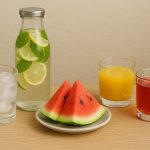Staying adequately hydrated is fundamental to overall health and wellbeing. It impacts everything from cognitive function and energy levels to skin vitality and digestive efficiency. While water remains the gold standard for hydration, many people find it challenging to drink enough throughout the day. This is where incorporating hydrating fruits into your diet can be a game-changer. Fruits aren’t just delicious; they’re naturally packed with water, electrolytes, and essential vitamins that contribute to optimal bodily function. However, simply eating any fruit isn’t always the answer – some fruits can cause digestive discomfort or lead to rapid sugar spikes if consumed in large quantities. This article will explore the best hydrating fruits you can enjoy without overloading your system, focusing on both their water content and digestibility, offering a balanced approach to staying refreshed.
The key is finding fruits that offer substantial hydration without causing bloating, gas, or other digestive issues. Many fruits contain fructose, a natural sugar that some individuals struggle to process efficiently. Overconsumption of high-fructose fruits can lead to uncomfortable symptoms and potentially impact gut health over time. We’ll examine fruits with lower fructose levels or those easily digestible, providing options suitable for various dietary needs and sensitivities. The goal isn’t just about consuming water-rich foods; it’s about integrating them into a lifestyle that promotes sustained hydration and overall wellness. Think of these fruits as valuable allies in your daily hydration strategy – tasty, convenient, and beneficial to your health.
Top Hydrating Fruits for Sustained Refreshment
Watermelon is arguably the quintessential hydrating fruit, boasting approximately 92% water content. This makes it an excellent choice during hot weather or after physical activity. Beyond its high water content, watermelon also provides essential vitamins like Vitamin A and C, as well as antioxidants like lycopene, known for its potential health benefits. However, watermelon’s higher sugar content means moderation is key, especially for those monitoring their blood glucose levels. Consuming a reasonable portion – about a cup or two – can provide significant hydration without causing unwanted spikes.
Strawberries are another fantastic option, containing around 91% water. They’re also rich in Vitamin C and antioxidants, offering a boost to the immune system. Unlike watermelon, strawberries have a relatively low glycemic index, meaning they release sugar more slowly into the bloodstream. This makes them a good choice for people with diabetes or those looking to manage their blood sugar levels. They’re versatile too – perfect on their own, in smoothies, or as a topping for yogurt.
Cantaloupe follows closely with around 90% water content and is packed with Vitamin A and potassium. Potassium is an important electrolyte lost through sweat during exercise, making cantaloupe a great post-workout snack. The fiber content in cantaloupe also contributes to digestive health. Similar to strawberries, it has a moderate glycemic index, making it easier to integrate into a balanced diet. Combining these fruits – watermelon, strawberries and cantaloupe – provides diverse nutrients alongside effective hydration, ensuring you’re not just drinking water but also nourishing your body with vital vitamins and minerals.
Understanding Fructose Levels and Digestive Tolerance
Fructose malabsorption is a condition where the small intestine struggles to absorb fructose efficiently. This can lead to bloating, gas, abdominal pain, and diarrhea. While many fruits contain fructose, some have lower levels than others, making them more easily digestible for those with sensitivities. Fruits like berries (strawberries, blueberries, raspberries) generally have lower fructose content compared to apples, pears, or mangoes. It’s important to note that individual tolerance varies greatly. What bothers one person may not affect another.
A helpful strategy is to combine high-fructose fruits with low-fructose options. For example, pairing a slice of mango (high in fructose) with a handful of blueberries (low in fructose) can help mitigate digestive discomfort. Additionally, cooking or processing fruit can sometimes improve its digestibility by breaking down some of the fructose molecules. However, this doesn’t eliminate the fructose entirely.
Pay attention to your body’s signals. If you experience bloating or discomfort after eating certain fruits, it may be a sign that you need to reduce your intake or choose alternatives with lower fructose levels. Keeping a food diary can help identify trigger foods and adjust your diet accordingly. Remember, listening to your gut is crucial for maintaining digestive health and enjoying the benefits of hydrating fruits without unwanted side effects. Understanding how different foods affect *your* body can be enhanced through practices like those in better flow regulation through body literacy.
Incorporating Hydrating Fruits into Your Daily Routine
Making hydration a habit doesn’t require drastic changes. Simple adjustments to your daily routine can make a significant difference. Start by adding a serving of hydrating fruit to your breakfast, such as sliced strawberries on oatmeal or blueberries in yogurt. This sets a positive tone for the day and encourages consistent fluid intake.
Throughout the day, keep pre-cut fruit readily available as a convenient snack option. Having it visible and accessible makes you more likely to choose it over less healthy alternatives. Consider adding slices of cucumber or lemon to your water bottle – not technically fruits but excellent hydrators that subtly enhance flavor. Another effective method is preparing smoothie blends using hydrating fruits like watermelon, berries, and spinach for a quick and nutritious hydration boost. For those seeking further support, exploring best hydrating herbs for daily urology support may be beneficial.
Finally, be mindful of portion sizes. While these fruits are healthy and hydrating, overconsumption can lead to digestive issues or excessive sugar intake. Aim for moderate portions – about one cup per serving – and focus on variety to ensure you’re getting a wide range of nutrients. Prioritize consistency over quantity; small, regular intakes of hydrating fruits are more effective than infrequent large servings.
Beyond the Fruit: Combining with Electrolytes & Water
While fruits provide excellent hydration, they don’t always contain sufficient levels of electrolytes – minerals like sodium, potassium, and magnesium that are essential for maintaining fluid balance. During periods of intense physical activity or in hot weather, we lose electrolytes through sweat. To replenish these lost minerals, consider combining hydrating fruits with electrolyte-rich beverages or foods. Coconut water is a natural source of electrolytes, as are bananas (though slightly higher in fructose).
Adding a pinch of sea salt to your fruit salad can also help boost sodium levels, contributing to better hydration and preventing muscle cramps. Remember that water is still the foundation of hydration. Fruits should complement, not replace, adequate water intake. Aim to drink water consistently throughout the day, even when consuming hydrating fruits. It’s important to note that balancing hydration without overloading the bladder is also key for comfortable and effective fluid management.
A practical approach is to track your fluid intake and adjust it based on your activity level and environmental conditions. If you’re exercising vigorously or spending time in a hot climate, increase both your water and electrolyte consumption. By combining hydrating fruits with adequate water and electrolytes, you can optimize your hydration strategy and support overall health and wellbeing. Maintaining consistent hydration throughout the day is also supported by understanding best hydration gaps between meals for flow ease.
Furthermore, being mindful of potential impacts on urinary health can be addressed with knowledge from resources like fruits that hydrate without overstimulating the system, ensuring a comfortable experience.
For those concerned about how their diet impacts urinary health and flow, exploring hydrating without overstimulating the urinary tract can offer valuable insights.





















